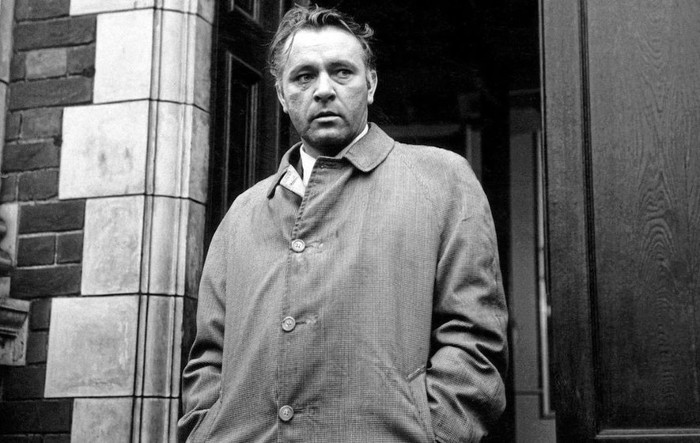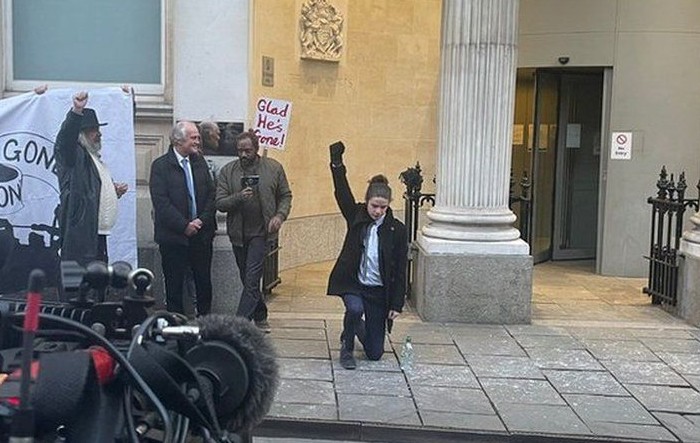
Above, Richard Burton in the role of MI6 Station Chief Alec Leamas in the 1965 movie, “The Spy Who Came In from the Cold” based on the 1963 novel of the same name by John le Carré. The movie also starred Claire Bloom and Oskar Werner.
I can heartily recommend the DVD – it is B&W but that adds to the feel of the movie. The movie brings home the dark gritty underworld of espionage in stark contrast to the glitzy glamour of the Bond movies. Burton underplayed the role magnificently.
During the era of the “Cold War” politics seemed to b so much simpler. Not only was the 1965 movie deliberately made in B&W – at a time when colour movies had been long established – but the politics were as well.
This was one reason why people are nostalgic about the period! You had the USSR and the Warsaw Pact and you had the USA and NATO. The Communists were totalitarian and “the West” were democracies.
I remember recently listening to a TV programme (I forget which) where one of characters asked if a trial was political which brought forth the response from an official, “we don’t have those in this country.”
This was a correct answer – in as far as it went. Political trials such as the one that convicted Aung San Suu Kyi in Burma are not conducted in the UK. However: There ARE political trials! The difference being that political trials in the UK are conducted by the defendants and NOT the Crown Prosecution Service!
The recent acquittal of Sage Willoughby, Rhian Graham, Milo Ponsford and Jake Skuse on the charge of causing criminal damage to the statue of the long dead Edward Colston demonstrates this perfectly.
The defendants turned the trial into a political one in two stages.
The first stage was to opt for trial by jury and not trial by magistrates.
When charged with an “either-way” offence (meaning the defendant can choose as above) their solicitor will point out the pros and cons. They will point out that whilst there is sometimes a greater chance of an acquittal at the Crown Court the sentence range is much higher which could mean upon conviction a heavier sentence than had they appeared before the magistrates.
The second stage was to adopt the dangerous high risk strategy of pleading Not Guilty but then conceding (accepting it) ALL the prosecution’s evidence and relying on asking the twelve members of the jury to acquit them anyway, arguing that they were completely justified in doing what they did!
The strategy is very dangerous and high risk and takes great courage on the part of the defendants to adopt this. One can call it the “All or Nothing” strategy or “Prison or Pardon” strategy. This because the defendants are admitting to the offence but are asking the jury to pardon them for their actions!
By doing this they are in fact committing a de-facto contempt of the justice system. This because the judge – an experienced lawyer – has been appointed by the Crown to deputise for the sovereign. This because it is the sovereign that has the power to convict and punish offenders and has the power to pardon them.
A Royal Pardon – like a Presidential Pardon in the USA – is an act by the head of state to pardon an offender for the crime they have committed.
What the “Bristol Four” did was to ask the jury and NOT the sovereign to pardon them!
IF the jury had decided to ignore the “Bristol Four’s” plea and convict them on the basis that the evidence presented by the CPS was not disputed by them they would have faced the real risk of a severe penalty from the judge.
This NOT because the judge will have been in any way biased but because of the sentencing guidelines they have to follow!
You see when an offender is convicted there are aggravating and mitigating circumstances to take into account.
A key aggravating circumstance is acceptance of guilt. This is why pleading guilty attracts a lighter sentence. Another aggravating or mitigating circumstance is the degree of remorse shown by the offender for their offence. Had the “Bristol Four” pleaded guilty and by their behaviour since their arrest had demonstrated true remorse for their actions the judge would have taken that into account as a mitigating factor.
However the “Bristol Four” by their behaviour since their arrest and their brazen conduct during the trial had demonstrated no remorse but the very opposite! They were proud of their actions and had the effrontery to ask the jury to acquit them because they declared that they were entitled to do what they did!
This is an aggravating factor on steroids!
The lawyers would have pointed out to the “Bristol Four” that to convict or acquit them, the jury would be required to reach a decision by a majority of 10 to 12 – if they were unable to deliver a unanimous decision. They will also have been advise that it would be quite possible – and in fact they were probably advised as to this being the most likely outcome – that a “hung jury” would result. This meant that at least 3 jurors decided to acquit or convict whilst the 9 others were minded to do the opposite. In these circumstances the CPS has the option of seeking a retrial or dropping the case.
It is clear that the “Bristol Four” were prepared to risk conviction and a possible custodial sentence in order to wear the Crown of Martyrdom!
The actions of the “Bristol Four” do in fact serve a very valuable lesson to us all. That jury trials are the citizen’s defence against tyranny. IF a defendant argues the prosecution is unjustified in bring a charge and the jury agrees it means that we all of us have a defence that Aung San Suu Kyi does NOT!
The problem we have in 2022 was that the trial of the “Bristol Four” was not an example “in extremis”.
The problem we have in 2022 and beyond is “What happens next?”
Let us suppose that the authorities get round to commissioning and erecting a statue to take the place of Edward Colston. Let us suppose for sake of argument that they decide to commission and erect a statue of the late Archbishop Desmond Tutu. Then let us suppose that a person or persons topple the statue not as part of a rowdy crowd but using such as a heavy tow truck in the “wee small hours”.
NB: The above statement does not and must not be construed as constituting encouragement or a suggestion to commit such or similar an act!
Let us suppose they adopt the same strategy as the “Bristol Four” arguing that the acquittal of the “Bristol Four” was a blatant political act and that defendant’s actions should be treated the same!
This will present an invidious challenge to the justice system. This because if the persons were convicted and sentenced to a term of imprisonment the “right wing” press would loudly point out the disparity of treatment. It then would not be a case of the “Bristol Four” wear the Crown of Martyrdom but the right wingers whose plea to the jury fell in deaf ears!

That the “Bristol Four” are politically motivated and would be described as many as being “wokeists” is demonstrated by the image above of Mr Sage Willoughby “taking the knee” outside the court!
One could almost put these two questions to the young man:
Question: To the charge of Criminal Damage. Do you plead guilty or not guilty?
Likely Answer: Not guilty.
Question: To the charge of being in possession of White Guilt. Do you plead guilty or not guilty?
Likely Answer: Guilty.
NB: Were the second charge to be put to me I would plead “Not Guilty!”
Doubtless Mr Willoughby will consider me a racist as a result!
Do I care?
No.

I question the impartiality of the jury. A public statue erected at a cost to the tax payer can only be removed with the approval of the local council. Dragging it from its plinth and throwing into the water is criminal damage. The jury, in my opinion, got it wrong. The crown must appeal.
We must not let mob rule take over. Democracy is the only way.